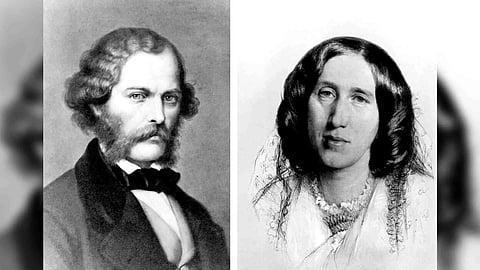

ALEXANDRA JACOBS
We could all use a hype man like George Henry Lewes. George Henry Who’s? Well, exactly. A “litterateur, physiologist and metaphysician,” as an obituary in The New York Times called him in 1878, Lewes is today most remembered as the longtime romantic partner and de facto agent of George Eliot: author of works consistently ranked among the best of Victorian literature — perhaps all of English literature. “A novel without weakness” was how the generally unsparing Martin Amis assessed her “Middlemarch,” the mistress-piece to which Rebecca Mead, a writer for The New Yorker, devoted an entire memoir.
For yes, in case you’ve been living under a giant rockery, George Eliot was a “her,” with several roles other than her nom de plume: daughter, sister, friend, wife, stepmother. There have been a gazillion biographies of the great woman, starting with the one assembled by her only legal, late-in-life husband, John Cross (who was 20 years younger and notoriously attempted suicide on their honeymoon, flinging himself into the Grand Canal of Venice from a balcony and getting fished out by a gondolier and hotel employee).
“The Marriage Question,” a careful but impassioned new book by Clare Carlisle, a philosophy professor who edited Eliot’s translation of Spinoza’s “Ethics,” is different in its close focus on an idea: that the titular institution shaped Eliot’s identity and work — and has some affinity with Carlisle’s own current undertaking. “Perhaps a biographer’s devotion is a little like the devotion of a spouse,” she observes, in an especially apt analogy for this noble but sometimes plodding literary endeavor. “Writing a person’s life means living with them intimately, struggling to understand them, wondering how far they can be trusted, dealing with the ways they resist, annoy, disappoint, challenge and elude you.”
Eliot’s various selves were denoted by name changes beyond the most obvious, which was occasioned, of course, by sexism and classism and probably inspired by not only her lover but one of his Paris acquaintances, the transgressive writer George Sand. The “double” life of Carlisle’s subtitle refers to the cover of pseudonym and to the powerful enrichment of a committed relationship. “It is a great experience — this marriage!” she exulted in a letter to a friend, “and all one’s notions of things before seem like the reading of a mystic inscription without the key.”
Born Mary Anne Evans in 1819, she lopped the “e” from “Anne” at 16, when her mother died; switched to the more sophisticated “Marian” at 32, when she moved from Coventry to London to become a writer; and for over two decades lived as “Mrs. Lewes” — though she and Mr. Lewes, who sometimes called her “Polly” or “Madonna,” were never technically married, as he had “a wife still living,” Agnes, who’d taken up with a friend of his.
The arrangement caused a scandal and her siblings shunned her. After a mostly triumphant career the author died in 1880 of kidney disease, at 61, and was buried in Highgate Cemetery as “Mary Ann Cross,” though that actual marriage, which finally won back her brother’s approval, had lasted less than a year.